XGBoost-Based Day-Ahead Load Forecasting Algorithm Considering Behind-the-Meter Solar PV Generation
Abstract
:1. Introduction
- Using the historical measured load, weather data and large-scale solar PV data, the capacity and generation of BTM solar PV generators for the entire system were estimated. Here, estimation of the capacity and generation of BTM solar PV generators was systematically performed in consideration of the effect of temperature and the load used by lighting appliances.
- The reconstituted load method was used to reflect the impact of BTM solar PV generation in load forecasting, and this method can eliminate the distortion of the electric load by adding the estimated BTM solar PV generation to the electric load.
- In order to improve the performance of the extreme gradient boosting (XGBoost) algorithm, a day-of-week (DoW) XGBoost model is proposed that classifies training data according to forecast target date. In addition, the proposed model was optimized for load forecasting through the sliding window-based time series validation method.
2. Electric Load Characteristic Analysis
3. Proposed Methodology
3.1. Data Preparation
3.2. Estimated the Amount of BTM Solar PV Generation
3.3. Load Forecasting Method Considering BTM Solar PV Generation
3.4. Modeling of XGBoost
4. Case Studies
4.1. Input Feature Selection and Hyperparameter Tuning
4.2. Empirical Results and Analysis
5. Conclusions
Author Contributions
Funding
Institutional Review Board Statement
Informed Consent Statement
Data Availability Statement
Conflicts of Interest
References
- Song, K.; Ha, S.; Park, J.; Kweon, D.; Kim, K. Hybrid load forecasting method with analysis of temperature sensitivities. IEEE Trans. Power Syst. 2006, 21, 869–876. [Google Scholar] [CrossRef]
- Park, R.; Song, K.; Kwon, B. Short-term load forecasting algorithm using a similar day selection method based on reinforcement learning. Energies 2020, 13, 2640. [Google Scholar] [CrossRef]
- López, J.C.; Rider, M.J.; Wu, Q. Parsimonious Short-Term Load Forecasting for Optimal Operation Planning of Electrical Distribution Systems. IEEE Trans. Power Syst. 2019, 34, 1427–1437. [Google Scholar] [CrossRef] [Green Version]
- Korea Power Exchange (KPX). Available online: https://www.kpx.or.kr (accessed on 20 August 2021).
- Electric Power Statistics Information System (EPSIS). Available online: https://epsis.kpx.or.kr (accessed on 11 December 2021).
- Eliana, V.; Hector, A.; Rodrigo, S. A Systematic Review of Statistical and Machine Learning Methods for Electrical Power Forecasting with Reported MAPE Score. Entropy 2020, 22, 1412. [Google Scholar]
- Fan, S.; Hyndman, R.J. Short-Term Load Forecasting Based on a Semi-Parametric Additive Model. IEEE Trans. Power Syst. 2011, 27, 134–141. [Google Scholar] [CrossRef] [Green Version]
- Clements, A.E.; Hurn, A.S.; Li, Z. Forecasting day-ahead electricity load using a multiple equation time series approach. Eur. J. Oper. Res. 2016, 251, 522–530. [Google Scholar] [CrossRef] [Green Version]
- Taylor, J.W. Short-Term Load Forecasting with Exponentially Weighted Methods. IEEE Trans. Power Syst. 2012, 27, 458–464. [Google Scholar] [CrossRef]
- Juan, M.V.; Ricardo, C.; Germán, A. Forecasting next-day electricity demand and price using nonparametric functional methods. Int. J. Electr. Power Energy Syst. 2012, 39, 48–55. [Google Scholar]
- Song, K.; Ha, S. An algorithm of short-term load forecasting. Trans. Korean Inst. Electr. Eng. 2004, 53, 529–535. [Google Scholar]
- Chia-Nan, K.; Cheng-Ming, L. Short-term load forecasting using SVR (support vector regression)-based radial basis function neural network with dual extended Kalman filter. Energy 2013, 49, 413–422. [Google Scholar]
- Azadeh, A.; Ghaderi, S.F.; Sheikhalishahi, M.; Nokhandan, B.P. Optimization of short load forecasting in electricity market of Iran using artificial neural networks. Optim. Eng. 2014, 15, 485–508. [Google Scholar] [CrossRef]
- Kaur, A.; Nonnenmacher, L.; Coimbra, C.F. Net load forecasting for high renewable energy penetration grids. Energy 2016, 114, 1073–1084. [Google Scholar] [CrossRef]
- Hadri, S.; NaitMalek, Y.; Najib, M.; Bakhouya, M.; Fakhri, Y.; El Aroussi, M. A Comparative Study of Predictive Approaches for Load Forecasting in Smart Buildings. Procedia Comput. Sci. 2019, 160, 173–180. [Google Scholar] [CrossRef]
- Kwon, B.; Park, R.; Song, K. Short-term load forecasting based on deep neural networks using LSTM layer. J. Electr. Eng. Technol. 2020, 15, 1501–1509. [Google Scholar] [CrossRef]
- Madrid, E.A.; Antonio, N. Short-Term Electricity Load Forecasting with Machine Learning. Information 2021, 12, 50. [Google Scholar] [CrossRef]
- Monforte, F.A.; Fordham, C.; Blanco, J.; Barsun, S.; Kankiewicz, A.; Norris, B. Improving Short-Term Load Forecasts by Incorporating Solar PV Generation: Interim Project Report; California Energy Commission: San Diego, CA, USA, 2016. [Google Scholar]
- Wang, F.; Li, K.; Wang, X.; Jiang, L.; Mi, Z.; Catalao, J.P. A distributed PV system capacity estimation approach based on support vector machine with customer net load curve features. Energies 2018, 11, 1750. [Google Scholar] [CrossRef] [Green Version]
- Li, K.; Yan, J.; Hu, L.; Wang, F.; Zhang, N. Two-Stage Decoupled Estimation Approach of Aggregated Baseline Load under High Penetration of Behind-the-Meter PV System. IEEE Trans. Smart Grid 2021, 12, 4876–4885. [Google Scholar] [CrossRef]
- Bu, F.; Dehghanpour, K.; Yuan, Y.; Wang, Z.; Zhang, Y. A data-driven game-theoretic approach for behind-the-meter PV generation disaggregation. IEEE Trans. Power Syst. 2020, 35, 3133–3144. [Google Scholar] [CrossRef] [Green Version]
- Li, K.; Wang, F.; Mi, Z.; Fotuhi-Firuzabad, M.; Duić, M.; Wang, T. Capacity and output power estimation approach of individual behind-the-meter distributed photovoltaic system for demand response baseline estimation. Appl. Energy 2019, 253, 113595. [Google Scholar] [CrossRef]
- Shaker, H.; Zareipour, H.; Wood, D. A data-driven approach for estimating the power generation of invisible solar sites. IEEE Trans. Smart Grid 2016, 7, 2466–2476. [Google Scholar] [CrossRef]
- Shaker, H.; Zareipour, H.; Wood, D. Estimating Power Generation of Invisible Solar Sites Using Publicly Available Data. IEEE Trans. Smart Grid 2016, 7, 2456–2465. [Google Scholar] [CrossRef]
- Wang, Y.; Zhang, N.; Chen, Q.; Kirschen, D.S.; Li, P.; Xia, Q. Data-driven probabilistic net load forecasting with high penetration of behind-the-meter PV. IEEE Trans. Power Syst. 2017, 33, 3255–3264. [Google Scholar] [CrossRef]
- Bae, D.; Kwon, B.; Woo, S.; Moon, C.; Song, K. The Estimation Algorithm of Behind-the-Meter Solar PV Capacities Considering Lighting Load. Trans. Korean Inst. Electr. Eng. 2021, 70, 742–749. [Google Scholar] [CrossRef]
- Korea Meteorological Agency (KMA) Weather Data Service. Available online: https://data.kma.go.kr (accessed on 20 August 2021).
- Lee, K.; Baek, H.; Cho, C. The Estimation of Base Temperature for Heating and Cooling Degree-Days for South Korea. J. Appl. Meteorol. Climatol. 2014, 53, 300–309. [Google Scholar] [CrossRef]
- Jo, S.; Park, R.; Kim, K.; Kwon, K.; Song, K. Sensitivity Analysis of Temperature on Special Day Electricity Demand in Jeju Island. Trans. Korean Inst. Electr. Eng. 2018, 67, 1019–1023. [Google Scholar]
- Korean Calendar. Available online: https://en.wikipedia.org/wiki/Korean_calendar (accessed on 20 August 2021).
- Chen, T.; Guestrin, C. XGBoost: A Scalable Tree Boosting System. In Proceedings of the 22nd ACM SIGKDD International Conference on Knowledge Discovery Data Mining, San Francisco, CA, USA, 13–17 August 2016; pp. 785–794. [Google Scholar]
- XGBoost Documentation. Available online: https://xgboost.readthedocs.io (accessed on 20 August 2021).
- Scikit-Learn. Available online: https://scikit-learn.org (accessed on 20 August 2021).

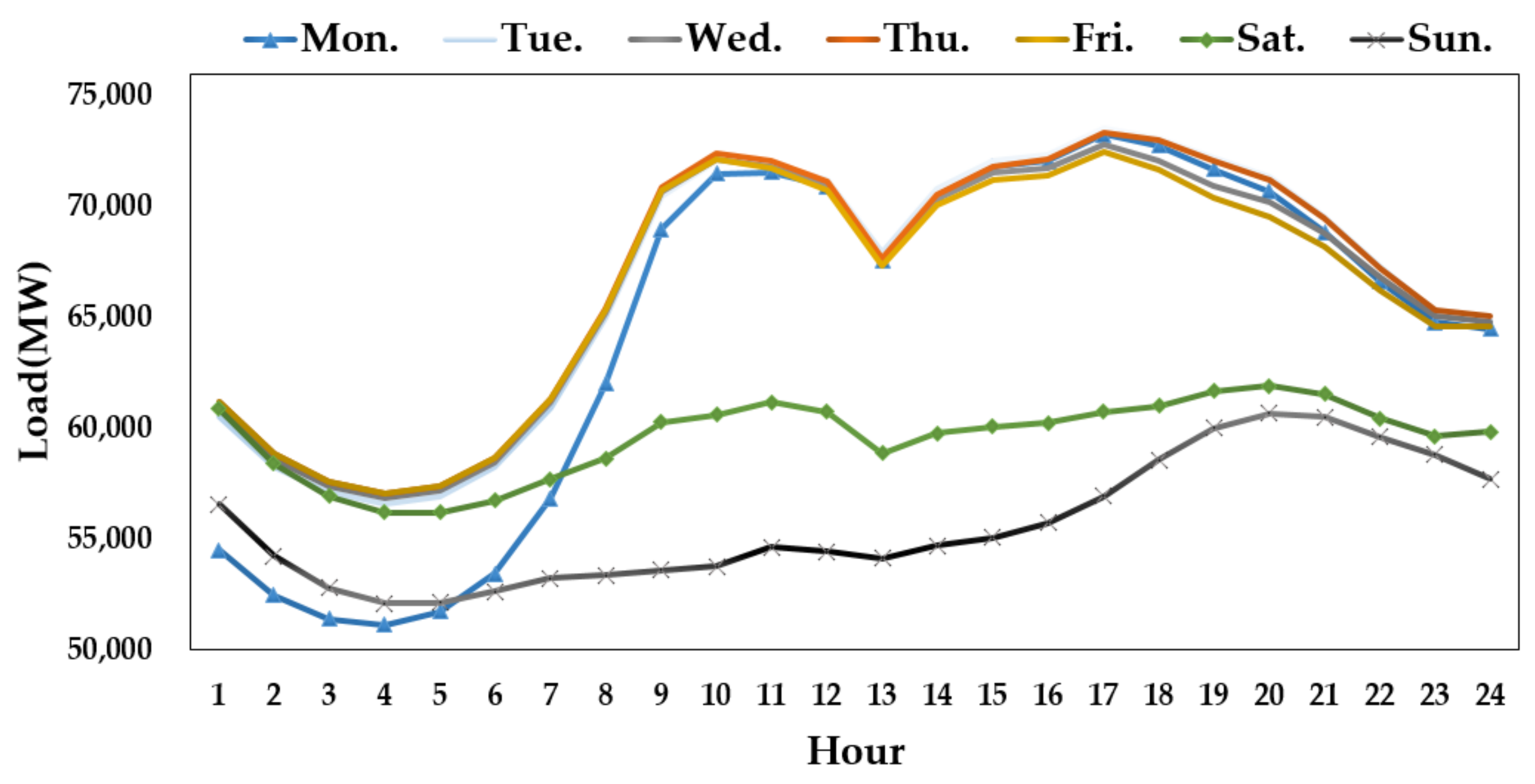

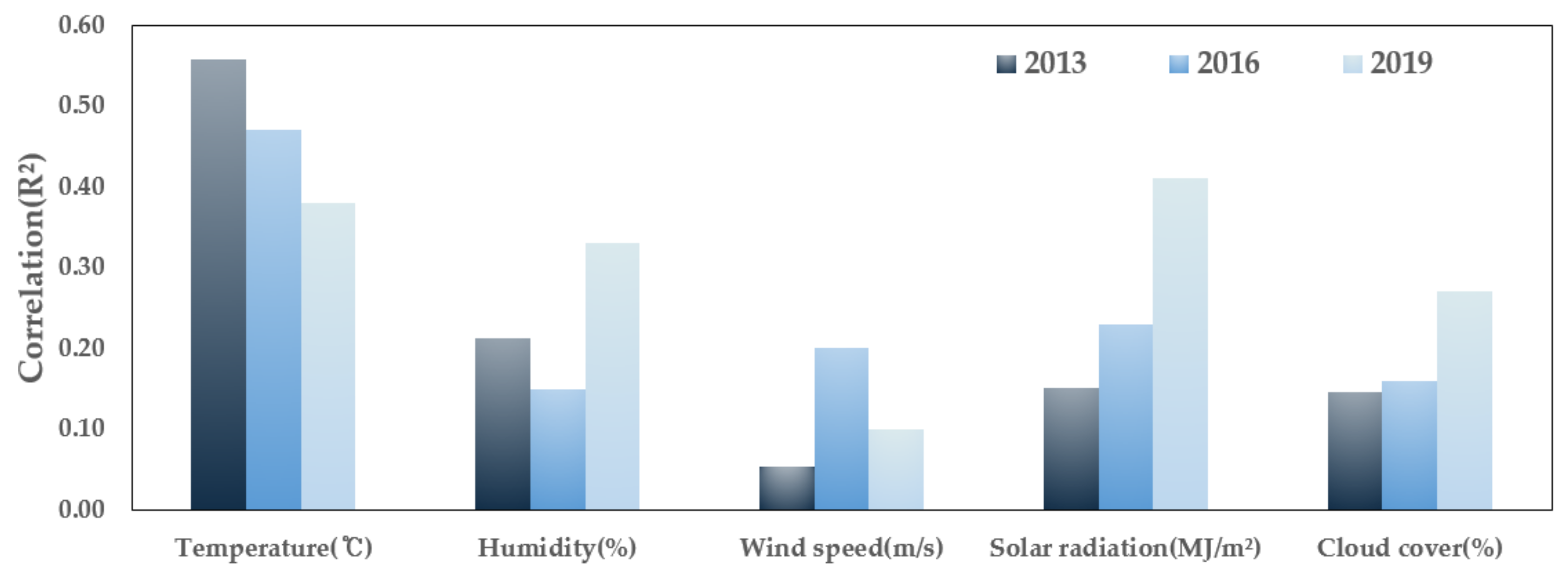
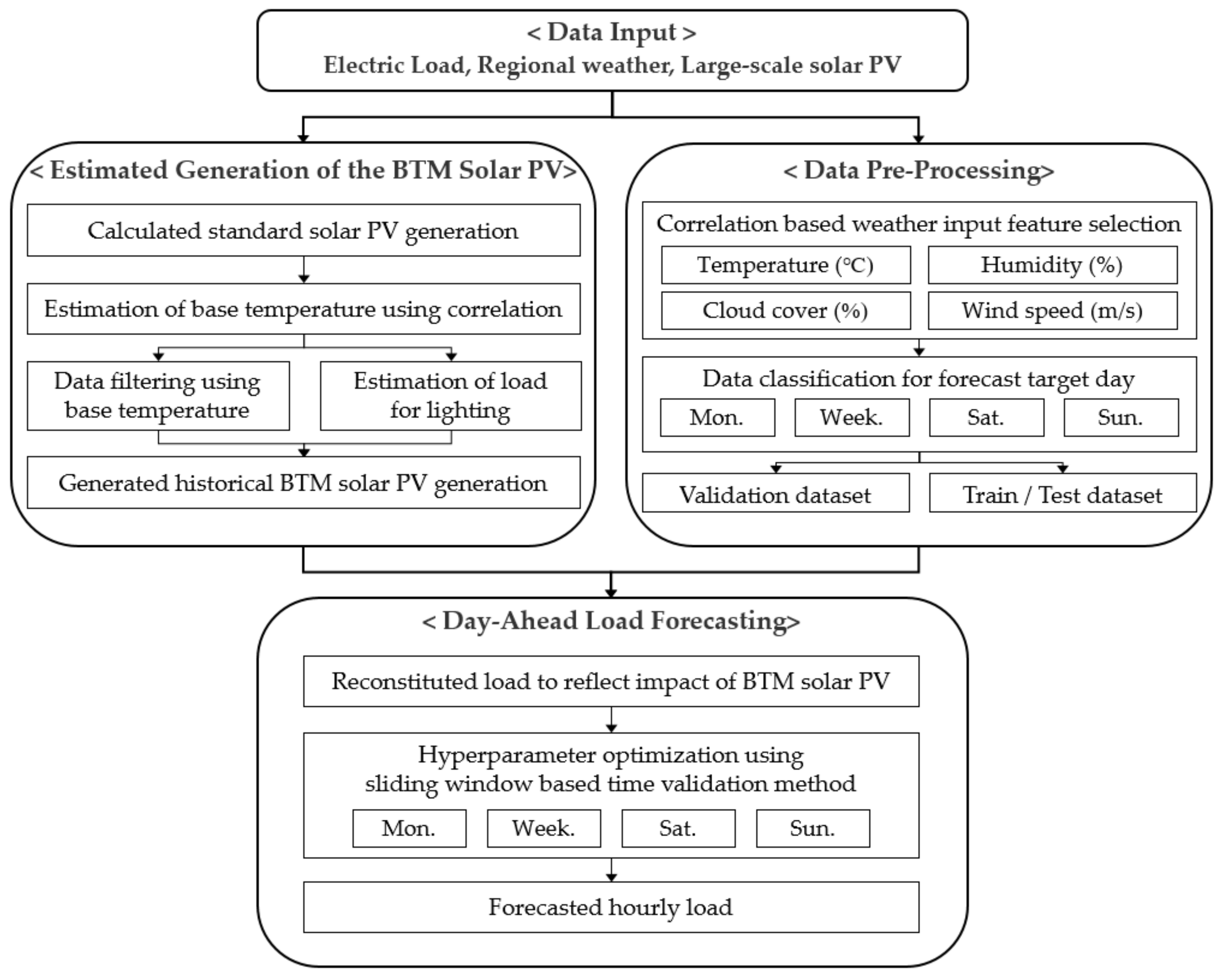
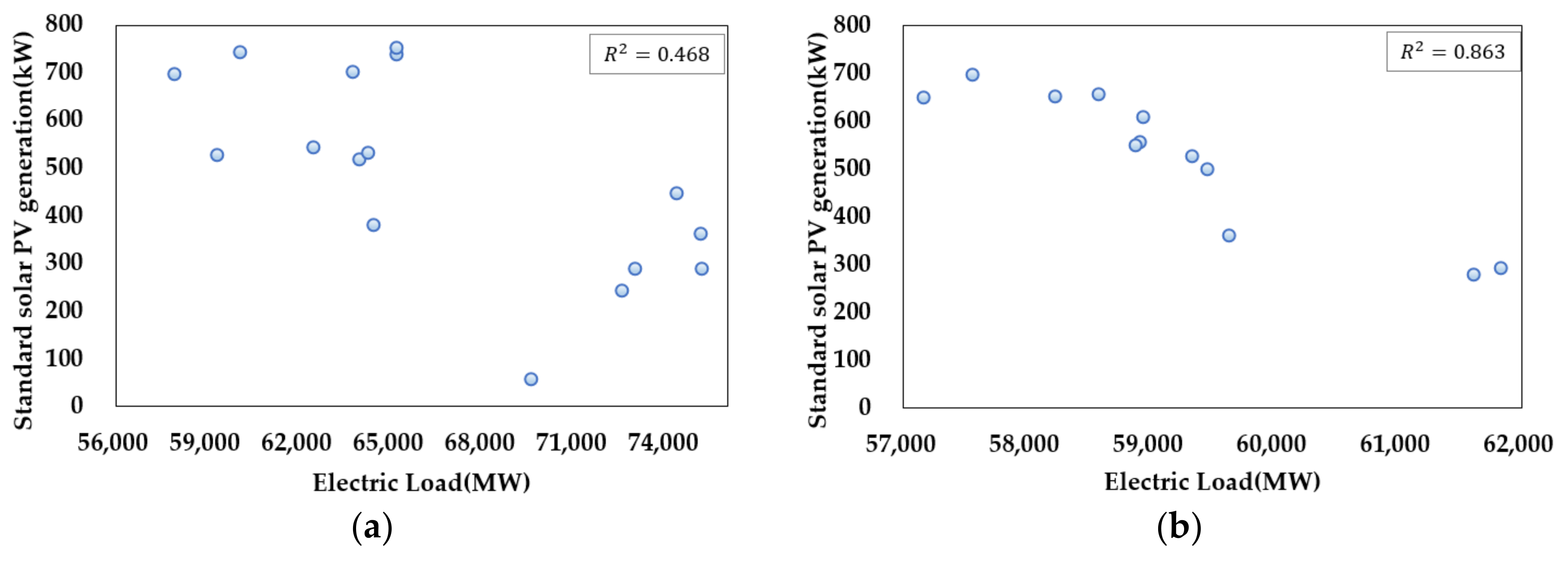
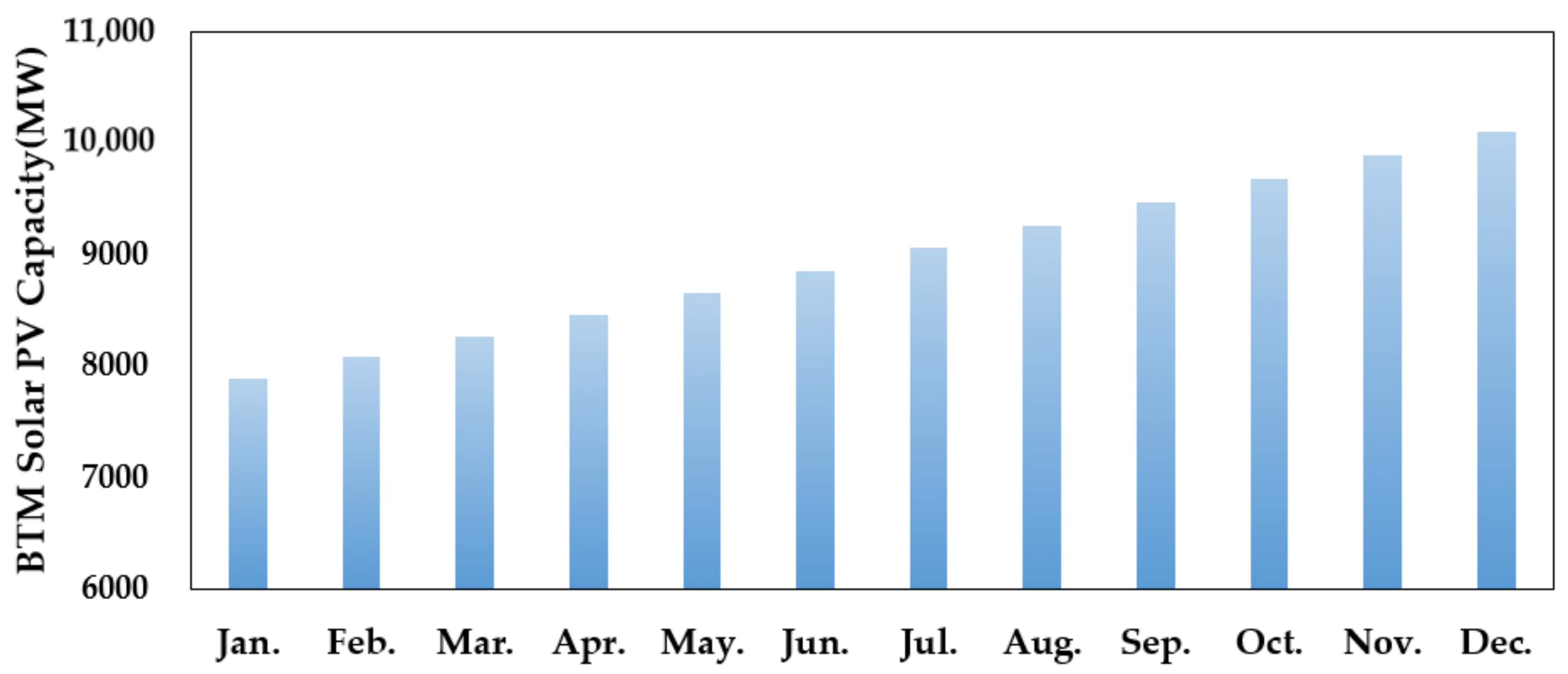


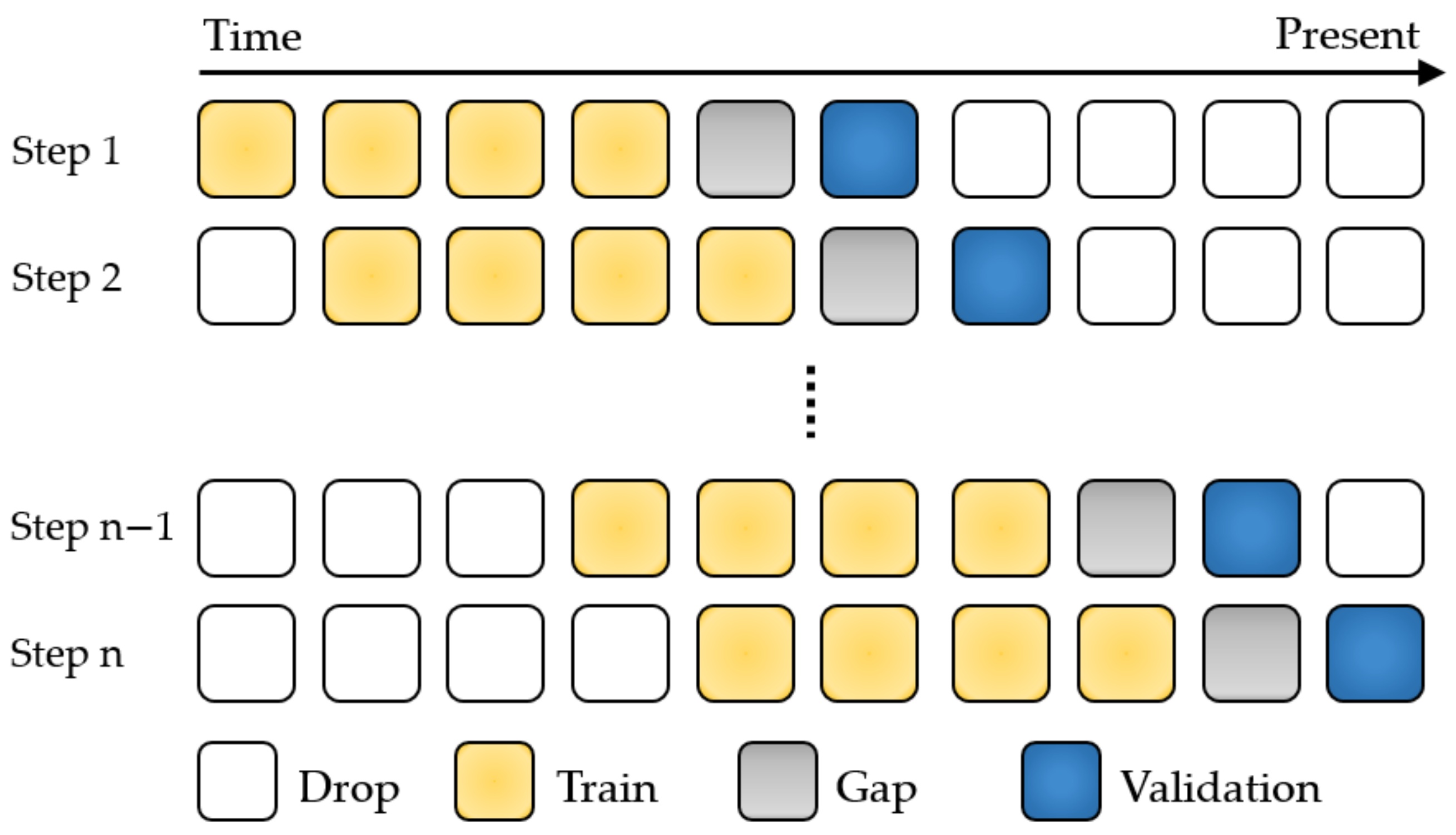
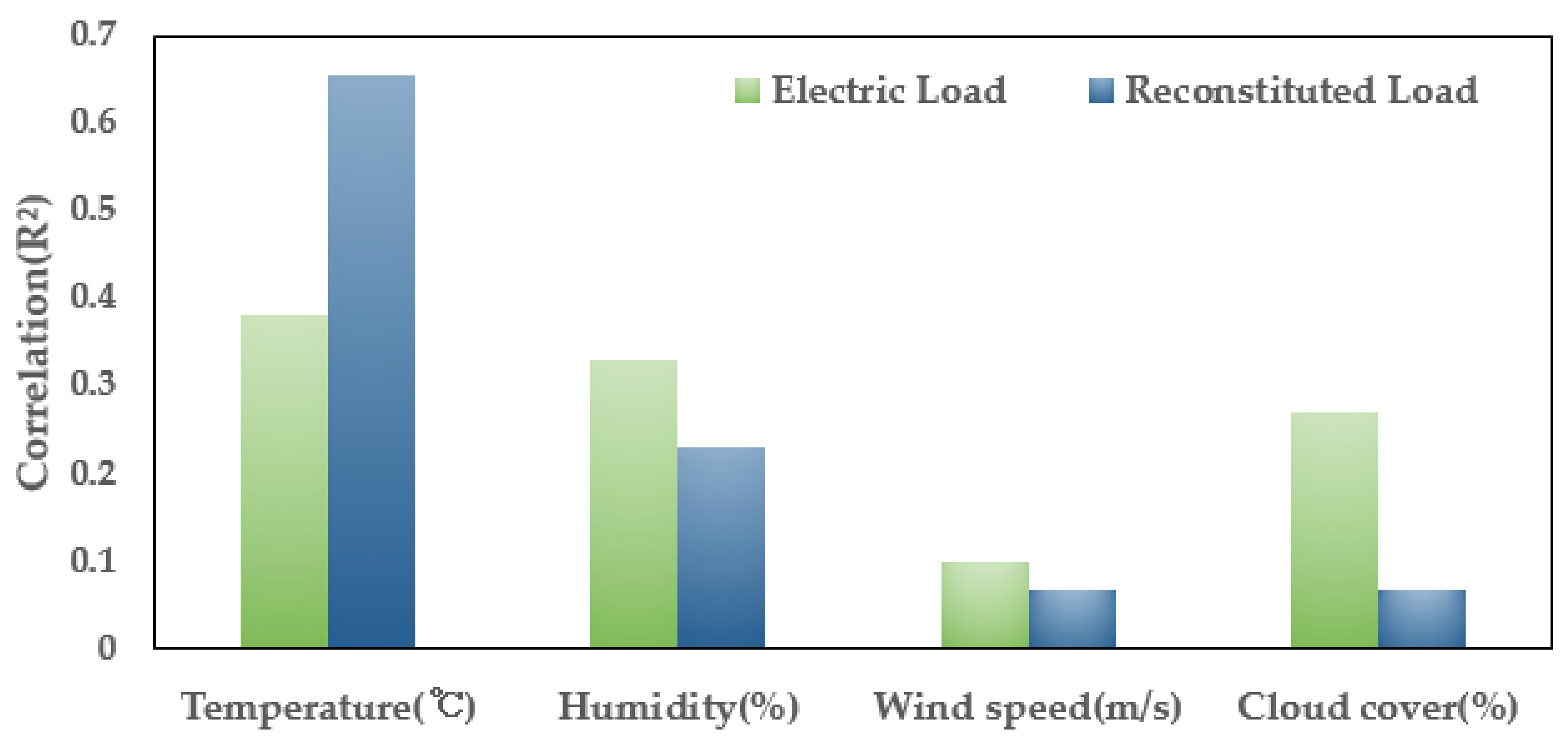
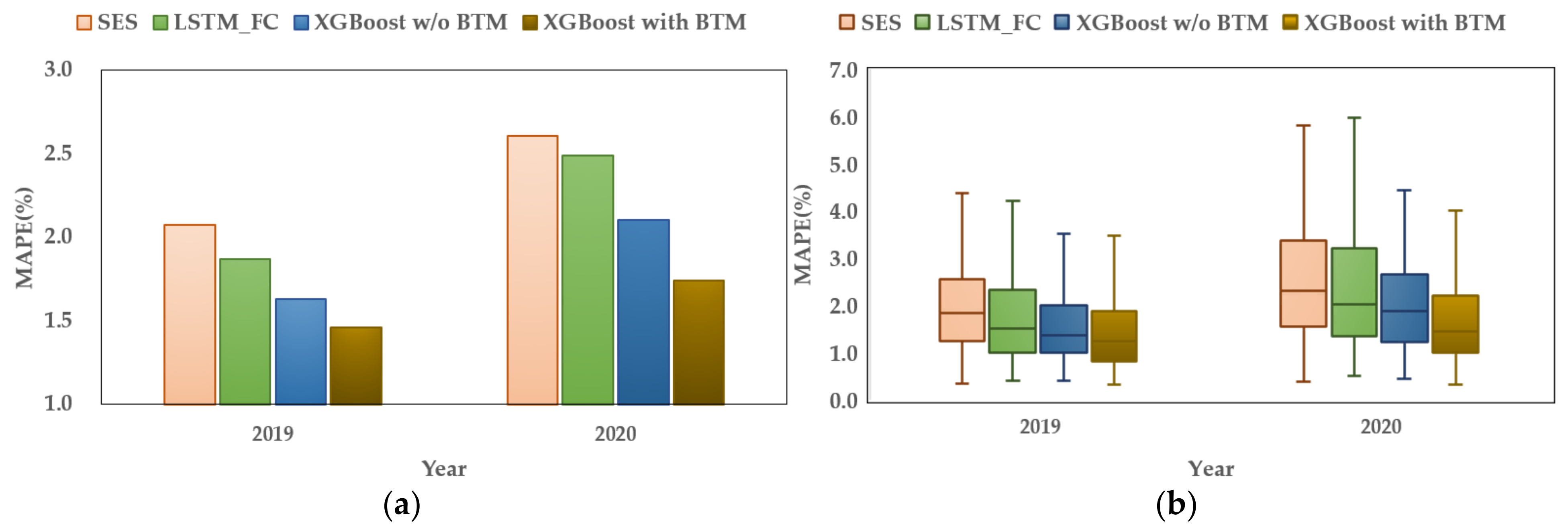

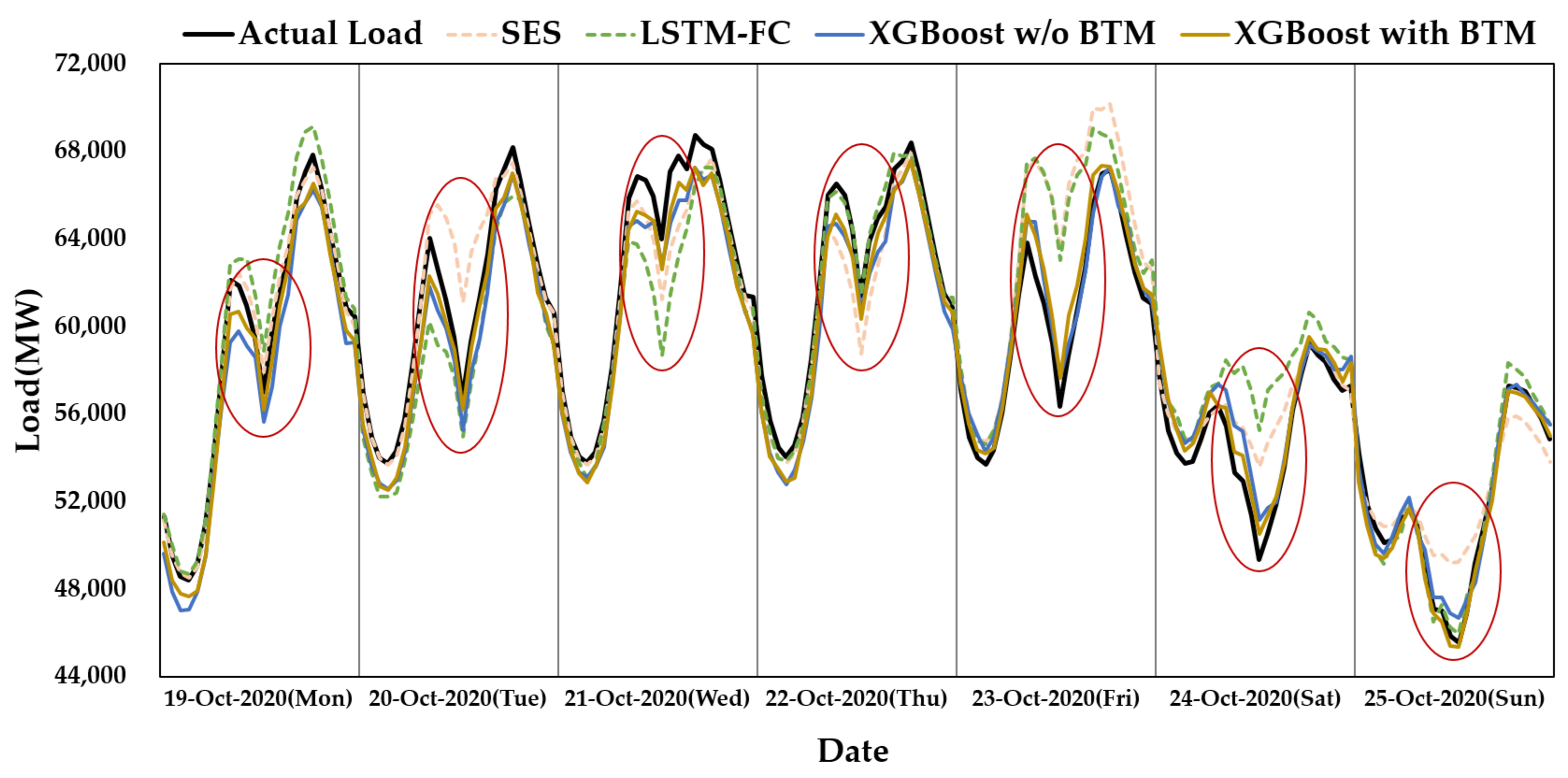
| Variable | Input Feature Name | Value/Unit |
|---|---|---|
| Weather | Hourly Temperature | ℃ |
| Hourly Cloud Cover | % | |
| Hourly Humidity | % | |
| Hourly Wind Speed | m/s | |
| Calendar | Day of the Week Code | 1–7: Mon.–Sun. |
| Holiday Code | 0: Non, 10: Holiday | |
| Target | Reconstituted Load | MW |
| Hyperparameter | Definition | Default |
|---|---|---|
| Booster | Which booster to use | gbtree |
| Max_depth | Maximum tree depth for base learners | 6 |
| Min_child_weight | Minimum sum of instance weight needed in a child | 1 |
| subsample | Subsample ratio of the training instances | 1 |
| n_estimators | Number of gradient-boosted trees | 100 |
| Forecasting Method | Weather Input Feature | Target |
|---|---|---|
| SES | Temperature (°C) | Electric Load |
| LSTM-FC | Temperature (°C) | Electric Load |
| XGBoost w/o BTM | Temperature (°C), Humidity (%), Cloud Cover (%) | Electric Load |
| XGBoost with BTM (Proposed Method) | Temperature (°C) | Reconstituted Load |
| Forecasting Method | DoW | Max_Depth | Min_Child_Weight | Subsample |
|---|---|---|---|---|
| XGBoost w/o BTM | Mon. | 6 | 2 | 0.6 |
| Week. | 3 | 2 | 0.9 | |
| Sat. | 3 | 2 | 0.7 | |
| Sun. | 5 | 4 | 0.9 | |
| XGBoost with BTM (Proposed Method) | Mon. | 3 | 4 | 0.9 |
| Week. | 4 | 3 | 0.9 | |
| Sat. | 3 | 2 | 0.8 | |
| Sun. | 4 | 4 | 0.9 |
| Errors | SES | LSTM-FC | XGBoost w/o BTM | XGBoost with BTM | |
|---|---|---|---|---|---|
| 2019 | Total MAPE | 2.06% | 1.86% | 1.63% | 1.46% |
| Peak Load MAPE | 1.91% | 1.83% | 1.58% | 1.57% | |
| Valley Load MAPE | 2.01% | 1.64% | 1.60% | 1.40% | |
| RMSE | 1732 MW | 1693 MW | 1393 MW | 1263 MW | |
| 2020 | Total MAPE | 2.60% | 2.48% | 2.11% | 1.75% |
| Peak Load MAPE | 2.32% | 2.46% | 1.99% | 1.67% | |
| Valley Load MAPE | 2.68% | 2.18% | 2.15% | 1.83% | |
| RMSE | 2124 MW | 2198 MW | 1658 MW | 1368 MW |
Publisher’s Note: MDPI stays neutral with regard to jurisdictional claims in published maps and institutional affiliations. |
© 2021 by the authors. Licensee MDPI, Basel, Switzerland. This article is an open access article distributed under the terms and conditions of the Creative Commons Attribution (CC BY) license (https://creativecommons.org/licenses/by/4.0/).
Share and Cite
Bae, D.-J.; Kwon, B.-S.; Song, K.-B. XGBoost-Based Day-Ahead Load Forecasting Algorithm Considering Behind-the-Meter Solar PV Generation. Energies 2022, 15, 128. https://doi.org/10.3390/en15010128
Bae D-J, Kwon B-S, Song K-B. XGBoost-Based Day-Ahead Load Forecasting Algorithm Considering Behind-the-Meter Solar PV Generation. Energies. 2022; 15(1):128. https://doi.org/10.3390/en15010128
Chicago/Turabian StyleBae, Dong-Jin, Bo-Sung Kwon, and Kyung-Bin Song. 2022. "XGBoost-Based Day-Ahead Load Forecasting Algorithm Considering Behind-the-Meter Solar PV Generation" Energies 15, no. 1: 128. https://doi.org/10.3390/en15010128






